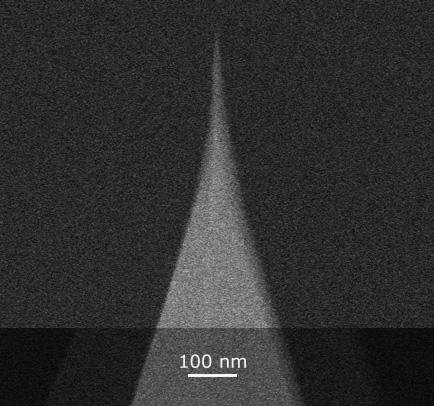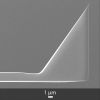
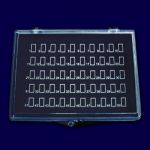
Check out the BudgetSensors® Combo BoxThu Sep 10 2020
BudgetSensors’ unique BudgetComboBox allows you to compile your personalized box of different AFM probes.
With the BudgetComboBox you take advantage of our built-in volume discounts for boxes of 50 probes without having to order 50 identical AFM probes.


Plant-Based Scaffolds Modify Cellular Response to Drug and Radiation Exposure Compared to Standard Cell Culture ModelsTue Sep 08 2020
Plant-based scaffolds present many advantages over a variety of biomaterials.*
Recent studies explored their potential to be repopulated with human cells and thus highlight a growing interest for their use in tissue engineering or for biomedical applications. However, it is still unclear if these in vitro plant-based scaffolds can modify cell phenotype or affect cellular response to external stimuli.*
In the research article “Plant-Based Scaffolds Modify Cellular Response to Drug and Radiation Exposure Compared to Standard Cell Culture Models “ Jerome Lacombe, Ashlee F. Harris, Ryan Zenhausern, Sophia Karsunsky and Frederic Zenhausern report the characterization of the mechano-regulation of melanoma SK-MEL-28 and prostate PC3 cells seeded on decellularized spinach leaves scaffolds, compared to cells deposited on standard rigid cell culture substrate, as well as their response to drug and radiation treatment.*
In their study the authors show that plant decellularization provide soft scaffolds that match the stiffness range of most of the human tissue and modify cell behavior, including drug and radiation response, compared to standard cell culture models. Because of their distinguished features (natural vasculature, low immunogenicity, low cost, relative ease, etc.) and their wide variations in the shape and structures, these scaffolds offer a multi-controllable model with multiple biochemical and biophysical interactions. However, additional studies are required to determine if they could address important architectural and physical challenges of the in vivo tissue environment.
For force measurement, the Young’s Modulus (YM) of the leaf scaffolds were determined using force spectroscopy mode at liquid interface with NANOSENSORS uniqprobe qp-BioAC AFM probes for leaves measurement.* https://www.nanosensors.com/uniqprobe-uniform-quality…
Please have a look at the NANOSENSORS blog for the full citation and a direct link to the full research article.


Photoresponsive Photoacid-Macroion Nano-AssembliesMon Aug 31 2020
In mother nature, the concept of self-assembly is vital for life, as it generates much of the functionality of living cells. It also bears great synthetic potential for the formation of versatile, switchable, and functional nanostructures.*
Noncovalent interactions can be triggered by external influences, such as the change of pH, light irradiation, thermal activation, introduction of a magnetic field, moisture, or redox response. Of high interest are light-responsive systems, for example in the fields of sensors or therapy, and, thus, it is desirable to explore novel concepts toward light-triggerable self-assembly.*
In the article “Photoresponsive Photoacid-Macroion Nano-Assemblies” Alexander Zika, Sarah Bernhardt and Franziska Gröhn present light-responsive nano-assemblies with light-switchable size based on photoacids.*
Anionic disulfonated napthol derivates and cationic dendrimer macroions are used as building blocks for electrostatic self-assembly. Nanoparticles are already formed under the exclusion of light as a result of electrostatic interactions. Upon photoexcitation, an excited-state dissociation of the photoacidic hydroxyl group takes place, which leads to a more highly charged linker molecule and, subsequently, to a change in size and structure of the nano-assemblies. The effects of the charge ratio and the concentration on the stability have been examined with absorption spectroscopy and -potential measurements.*
The influence of the chemical structure of three isomeric photoacids on the size and shape of the nanoscale aggregates has been studied by dynamic light scattering and atomic force microscopy, revealing a direct correlation of the strength of the photoacid with the changes of the assemblies upon irradiation.*
NanoWorld Ultra-Short AFM Cantilevers of the USC-F0.3-k0.3 type ( typical force constant 0.3 N/m ) were operated in tapping mode for the Atomic Force Microscopy (AFM) images presented in the article.* https://www.nanoworld.com/Ultra-Short-Cantilevers-USC-F0.3…
Please have a look at the NanoWorld blog for the full citation and a direct link to the full article.


Large-Area Graphene Oxide Films for Supercapacitor Electrodes, Transparent Conductive Films and FET'sWed Aug 26 2020
Nanotools tilt-corrected EBD-HAR high aspect ratio #AFMprobes https://www.nanoandmore.com/AFM-Probe-EBD-HAR with 800 nm length and 4˚ half cone angle featured in the interesting research article "Sensor characterization by comparative measurements using a multi-sensor measuring system" by Sebastian Hagemeier et al. Find out more in the nanotools blog https://www.nanotools.com/blog/index.html


Electric-field-driven non-volatile multi-state switching of individual skyrmions in a multiferroic heterostructureMon Aug 24 2020
Electrical manipulation of skyrmions attracts considerable attention for its rich physics and promising applications. To date, such a manipulation is realized mainly via spin-polarized current based on spin-transfer torque or spin–orbital torque effect.*
However, this scheme is energy consuming and may produce massive Joule heating. To reduce energy dissipation and risk of heightened temperatures of skyrmion-based devices, an effective solution is to use electric field instead of current as stimulus.*
In the article “Electric-field-driven non-volatile multi-state switching of individual skyrmions in a multiferroic heterostructure”, Yadong Wang, Lei Wang, Jing Xia, Zhengxun Lai, Guo Tian, Xichao Zhang, Zhipeng Hou, Xingsen Gao, Wenbo Mi, Chun Feng, Min Zeng, Guofu Zhou, Guanghua Yu, Guangheng Wu, Yan Zhou, Wenhong Wang, Xi-xiang Zhang and Junming Liu realize an electric-field manipulation of skyrmions in a nanostructured ferromagnetic/ferroelectrical heterostructure at room temperature via an inverse magneto-mechanical effect.*
Intriguingly, such a manipulation is non-volatile and exhibits a multistate feature. Numerical simulations indicate that the electric-field manipulation of skyrmions originates from strain-mediated modification of effective magnetic anisotropy and Dzyaloshinskii–Moriya interaction.*
The results presented in the article open a direction for constructing low-energy-dissipation, non-volatile, and multistate skyrmion-based spintronic devices.*
To minimize the influence of the magnetic field from the MFM tip on the magnetic domain structure during the magnetic force microscopy ( MFM ) measurements, NANOSENSORS™ PPP-LM-MFMR low moment magnetic AFM probes were used.* https://www.nanosensors.com/pointprobe-plus-magnetic-force…
These MFM probes are designed for magnetic force microscopy with reduced disturbance of the magnetic sample by the tip and enhanced lateral resolution compared to the standard PPP-MFMR probe. The distance between the tip and sample was maintained at a constant distance of 30 nm.*
Please have a look at the NANOSENSORS blog for the full citation and a direct link to the full article.

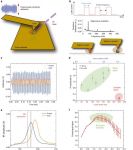
Single molecule secondary structure determination of proteins through infrared absorption nanospectroscopyMon Aug 24 2020
Determining secondary structure of single protein molecules with off-resonance short pulse infrared nanospectroscopy using MikroMasch HQ:NSC36/Al BS AFM probes.

NanoWorld Screencast on Ultra-Short Cantilevers (USC) for High-Speed AFM (HS-AFM) and video rate Atomic Force Microscopy passes 1000 views markMon Aug 17 2020
The NanoWorld screencast on Ultra-Short Cantilevers (USC) for High Speed AFM (HS-AFM) and video rate Atomic Force Microscopy held by Mathieu Burri has just reached the 1000 views mark. Congratulations Mathieu!
The Ultra-Short Cantilevers series https://www.nanoworld.com/ultra-short-cantilevers-afm-tips combines very small cantilevers capable of resonating in the MHz regime and a very sharp and wear resistant tip and is dedicated to High-Speed AFM (HS-AFM). The Ultra-Short Cantilevers series consists of six different types of probes which cover the complete range of high speed scanning applications, from non-contact mode to contact mode, from measurements in air to measurements in liquid.
More information such as high speed videos, an image gallery and a regularly updated reference list of scientific articles on high speed AFM can be found on the dedicated website: https://www.highspeedscanning.com/ . You can also find references to scientific articles mentioning the use of NanoWorld USC AFM probes on the NanoWorld blog.
If you haven’t seen the USC screencast yet have a look.


Insights into dynamic sliding contacts from conductive atomic force microscopyThu Aug 13 2020
Friction in nanoscale contacts is determined by the size and structure of the interface that is hidden between the contacting bodies. One approach to investigating the origins of friction is to measure electrical conductivity as a proxy for contact size and structure. However, the relationships between contact, friction and conductivity are not fully understood, limiting the usefulness of such measurements for interpreting dynamic sliding properties.*
In their study “Insights into dynamic sliding contacts from conductive atomic force microscopy” Nicholas Chan, Mohammad R. Vazirisereshk, Ashlie Martini and Philip Egberts used atomic force microscopy (AFM) to simultaneously acquire lattice resolution images of the lateral force and current flow through the tip–sample contact formed between a highly oriented pyrolytic graphite (HOPG) sample and a conductive diamond AFM probe to explore the underlying mechanisms and correlations between friction and conductivity. Both current and lateral force exhibited fluctuations corresponding to the periodicity of the HOPG lattice.
Unexpectedly, while lateral force increased during stick events of atomic stick-slip, the current decreased exponentially.*
The results presented in the study by Nicholas Chan et al. confirm that the correlation between conduction and atom–atom distance previously proposed for stationary contacts can be extended to sliding contacts in the stick-slip regime.*
A NANOSENSORS™ conductive diamond coated AFM probe CDT-CONTR was used to obtain all experimental data presented in their manuscript.* https://www.nanosensors.com/conductive-diamond-coated-tip…
Please have a look at the NANOSENSORS blog for the full citation and a direct link to the full article.

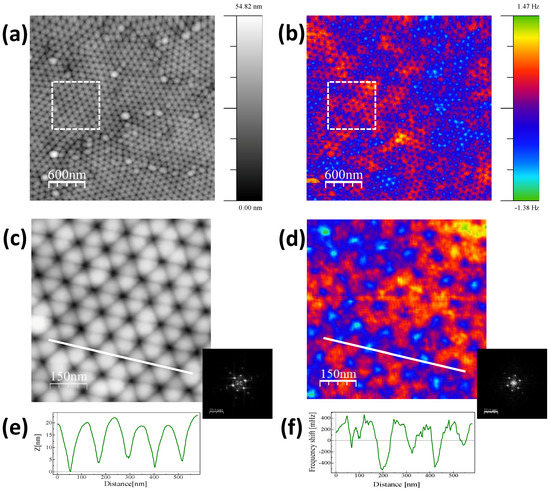
Tailoring a magnetization process with BudgetSensors MagneticMulti75-G MFM AFM probesThu Aug 13 2020
Tailoring the magnetization process of the magnetic materials studied with BudgetSensors MagneticMulti75-G MFM AFM probes.

Video on NANOSENSORS™ Membrane-type Surface-stress Sensors (MSS) for olfactory sensing passes 1500 views markTue Aug 11 2020
The video on NANOSENSORS™ Membrane-type Surface-stress Sensors (MSS) for olfactory sensing has passed the 1500 views mark. Thank you all for watching.
The NANOSENSORS™ Membrane-type Surface-stress Sensor – MSS is a non-packaged MEMS sensor, a silicon membrane platform supported with four beams on which piezoresistors are embedded. It is mainly dedicated to R&D in the areas of olfactory sensing and electronic noses.
There are currently two major applications for this type of sensor:
-- the MSS has a great potential as a core component for electronic (artificial) nose systems / olfactory sensing systems utilized in e.g., medical, food, environment, safety and security fields.
-- the MSS can also be used for assessment of various materials like organic conductors, magnetic and superconductor materials in torque magnetometry.
To find out more please have a look at the video or at the NANOSENSORS™ MSS webpage https://www.mss-sensor.com/ or the NANOSENSORS™Special Developments List https://www.nanosensors.com/pdf/SpecialDevelopmentsList.pdf . On these pages you will not only get more information on which types of MSS Sensors are currently available but you will also find further information on the NANOSENSORS™ MSS 8 Channel Readout Module ( MSS-8RM ). The MSS-8RM is a basic electronic module to operate and to readout NANOSENSORS™ MSS that can be integrated in the researchers own set-up.

Soft, drift-reduced AFM cantilevers for Biology and Life Sciences – Uniqprobe Screencast passes the 1000 views markThu Aug 06 2020
The screencast on the soft, drift-reduced NANOSENSORS™ uniqprobe cantilevers for biology and life science applications held by Dr. Laure Aeschimann has just passed the 1000 views mark. Congratulations Laure!
Since the first publication of this screencast that presents the uniqprobe types qp-BioAC, qp-BioT, qp-SCONT and qp-CONT , three further types of uniqprobe AFM probes have been introduced:
- qp-BioAC-CI – a version of uniqprobe™ BioAC with Rounded Tips for Cell Imaging
- qp-fast – three different uniqprobe™ cantilevers on one support chip for Soft- , Standard- , Fast Tapping/Dynamic AFM Imaging
and qp-HBC – the uniqprobe™ – HeartBeatCantilever
To find out more please have a look at the NANOSENSORS™ uniqprobe brochure https://www.nanosensors.com/…/3cfe8ca6ad48a762e2668b7d2b205… or the individual product pages on the NANOSENSORS webpage.
Additionally we have also put tipless versions of the qp-SCONT, qp-CONT and the qp-BioT ( SD-qp-BioT-TL, SD-qp-CONT-TL, SD-qp-SCONT-TL) and uniqprobe tipless cantilever arrays ( SD-qp-TL8a and SD-qp-TL8b ) on the NANOSENSORS special developments list. https://www.nanosensors.com/pdf/SpecialDevelopmentsList.pdf
Feel free to browse or let us know if you have any questions via info(at)nanosensors.com.


Influence of Ultraviolet Radiation Exposure Time on Styrene-Ethylene-Butadiene-Styrene (SEBS) CopolymerWed Aug 05 2020
In the article «Influence of Ultraviolet Radiation Exposure Time on Styrene-Ethylene-Butadiene-Styrene (SEBS) Copolymer» Daniel Garcia-Garcia , José Enrique Crespo-Amorós, Francisco Parres and María Dolores Samper describe how they studied the effect of ultraviolet radiation on styrene-ethylene-butadiene-styrene (SEBS) at different exposure times in order to obtain a better understanding of the mechanism of ageing.*
The results obtained for the SEBS, in relation to the duration of exposure, showed superficial changes that cause a decrease in the surface energy (s) and, therefore, a decrease in surface roughness. This led to a reduction in mechanical performance, decreasing the tensile strength by about 50% for exposure times of around 200 hours.*
NanoWorld Pointprobe® NCH AFM probes were used in the Atomic force microscopy (AFM) applied to determine the surface topography and roughness of the aged samples. https://www.nanoworld.com/pointprobe-tapping-mode-afm-tip…
Please have a look at the NanoWorld blog for the full citation and a direct link to the full article.

Direct Measurement of Adhesion Force of Individual Aerosol Particles by Atomic Force MicroscopyTue Aug 04 2020
In the article «Direct Measurement of Adhesion Force of Individual Aerosol Particles by Atomic Force Microscopy» Kohei Ono, Yuki Mizushima, Masaki Furuya, Ryota Kunihisa, Nozomu Tsuchiya, Takeshi Fukuma, Ayumi Iwata and Atsushi Matsuki describe a new method, namely, force–distance curve mapping, that was developed to directly measure the adhesion force of individual aerosol particles by atomic force microscopy.*
The proposed method collects adhesion force from multiple points on a single particle. It also takes into account the spatial distribution of the adhesion force affected by topography (e.g., the variation in the tip angle relative to the surface, as well as the force imposed upon contact), thereby enabling the direct and quantitative measurement of the adhesion force representing each particle.*
The results presented in the article highlight that the original chemical composition, as well as the aging process in the atmosphere, can create significant variation in the adhesion force among individual particles. This study demonstrates that force–distance curve mapping can be used as a new tool to quantitatively characterize the physical properties of aerosol particles on an individual basis.*
The measurement of adhesion force described in the article was performed in contact mode using silicon NANOSENSORS™ AdvancedTEC™ ATEC-CONT AFM tips.*
Please have a look at the NANOSENSORS blog for the full citation and a direct link to the full article.


Determination of polarization states in (K,Na)NbO3 lead-free piezoelectric crystalTue Aug 04 2020
Check out this article describing how polarization switching in lead-free (K0.40Na0.60)NbO3 (KNN) single crystals was studied by switching spectroscopy piezoresponse force microscopy (SS-PFM).
PFM and SS-PFM were implemented on a commercial Atomic Force Microscope using NanoWorld PlatinumIridium coated Pointprobe® EFM AFM probes. https://www.nanoworld.com/pointprobe-electrostatic-force…


MikroMasch rotated AFM tipsMon Jul 27 2020
When mounted at the standard 13⁰ angle in the AFM, the front and back edges of MikroMasch rotated AFM tips form the same 20⁰ angle to the vertical. This allows more symmetric visualization of topography features than when using non-rotated tips.


Happy birthday to Gerd BinnigMon Jul 20 2020
Happy birthday to Nobel prize laureate Gerd Binnig, coinventor of the Scanning Tunneling Microscope
and the Atomic Force Microscope!

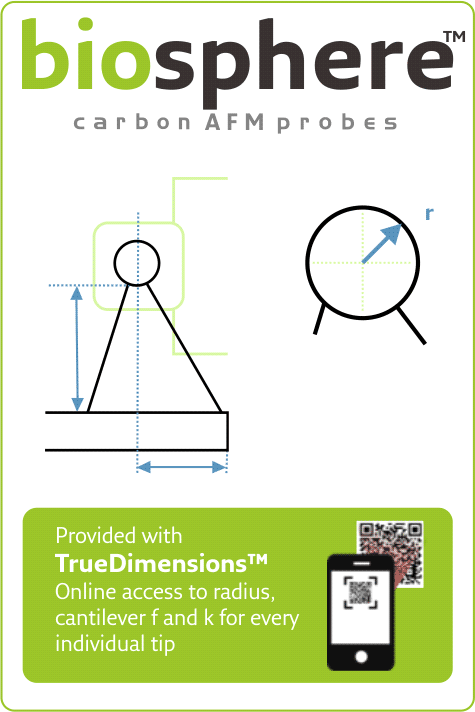
Nanotools biosphere™ AFM probes applied to study the mechanical properties of #PDMS filmsWed Jul 15 2020
Discover how nanotools biosphere™ AFM probes with precisely controlled 500 nm radius and pre-calibrated cantilevers is applied to study the mechanical properties of #PDMS films in the latest nanotools blogpost


Gentle plasma process for embedded silver-nanowire flexible transparent electrodes on temperature-sensitive polymer substratesTue Jul 14 2020
In the article “Gentle plasma process for embedded silver-nanowire flexible transparent electrodes on temperature-sensitive polymer substrates “ Lukas Kinner, Emil J W List-Kratochvil and Theodoros Dimopoulos investigate processing routes to obtain highly conductive and transparent electrodes of silver nanowires (AgNWs) on flexible polyethylene terephthalate (PET) substrate.*
Their study shows that both thermally stable polyimide, as well as temperature-sensitive PET can be used as flexible host substrates, combined with a gentle, AgNW plasma curing. This is possible by adjusting the fabrication sequence to accommodate the plasma curing step, depending on the host substrate. As a result, embedded AgNW electrodes, transferred from polyimide-to-PET and from PET-to-PET are obtained, with optical transmittance of ~80% (including the substrate) and sheet resistance of ~13 Ω/sq., similar to electrodes transferred from glass-to-glass substrates.*
The embedded AgNW electrodes on PET show superior performance in bending tests, as compared to indium-tin-oxide electrodes and can be easily combined with metal oxide films for device implementation. The introduced approach, involving low-cost flexible substrates, AgNW spray-coating and plasma curing, is compatible with high-throughput, roll-to-roll processing.*
The impact of the introduced processes concerns therefore applications where high-throughput production must be combined with sensitive, flexible substrates and ultra-thin device architectures, like OLEDs and organic- or perovskite-based photovoltaics.*
The sample surfaces were characterized with atomic force microscopy (AFM) in tapping mode, using high-resolution NANOSENSORS™ SuperSharpSilicon™ SSS-NCHR AFM probes. https://www.nanosensors.com/supersharpsilicon-non-contact…
Please have a look at the NANOSENSORS blog for the full citation and a direct link to the full article


Human ESCRT-III polymers assemble on positively curved membranes and induce helical membrane tube formationMon Jul 06 2020
The Endosomal Sorting Complex Required for Transport-III (ESCRT-III) is part of a conserved membrane remodeling machine. ESCRT-III employs polymer formation to catalyze inside-out membrane fission processes in a large variety of cellular processes, including budding of endosomal vesicles and enveloped viruses, cytokinesis, nuclear envelope reformation, plasma membrane repair, exosome formation, neuron pruning, dendritic spine maintenance, and preperoxisomal vesicle biogenesis.*
How membrane shape influences ESCRT-III polymerization and how ESCRT-III shapes membranes is yet unclear.*
In the article “Human ESCRT-III polymers assemble on positively curved membranes and induce helical membrane tube formation” Aurélie Bertin, Nicola de Franceschi, Eugenio de la Mora, Sourav Maity, Maryam Alqabandi, Nolwen Miguet, Aurélie di Cicco, Wouter H. Roos, Stéphanie Mangenot, Winfried Weissenhorn and Patricia Bassereau describe how human core ESCRT-III proteins, CHMP4B, CHMP2A, CHMP2B and CHMP3 are used to address this issue in vitro by combining membrane nanotube pulling experiments, cryo-electron tomography and Atomic Force Microscopy.*
The authors show that CHMP4B filaments preferentially bind to flat membranes or to tubes with positive mean curvature.*
The results presented in the article cited above underline the versatile membrane remodeling activity of ESCRT-III that may be a general feature required for cellular membrane remodeling processes.*
The authors provide novel insight on how mechanics and geometry of the membrane and of ESCRT-III assemblies can generate forces to shape a membrane neck.*
NanoWorld Ultra-Short AFM Cantilevers USC-F1.2-k0.15 were used for the High-speed Atomic Force Microscopy ( HS-AFM ) experiments presented in this article.* https://www.nanoworld.com/Ultra-Short-Cantilevers-USC-F1.2…
Please have a look at the NanoWorld blog for the full citation and a direct link to the full article.


A two-step method for rate-dependent nano-indentation of hydrogelsFri Jul 03 2020
Two-step method for accurate alignment of finite-rate nanoindentation curves on hydrogels using a colloidal AFM probe based on our MikroMasch NSC36/tipless/Cr-Au


